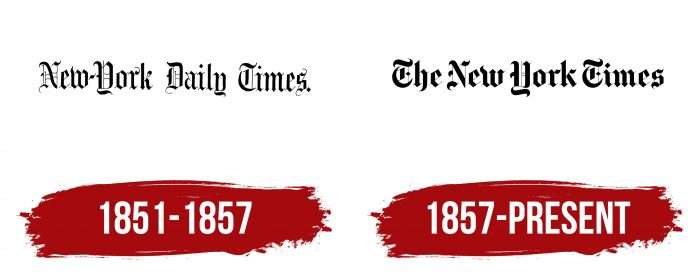The New York Times logo represents a respectable publication with a distinctive corporate identity. The emblem indicates the standards and rules that have been preserved since its foundation, an unusual vision of the world, and the ability to present a real exclusive to readers.
New York Times (NYT): Brand overview
| Founded: | September 18, 1851 |
| Founder: | Henry Jarvis Raymond, George Jones |
| Headquarters: | New York City, U.S. |
| Website: | nytimes.com |
Meaning and History
The New York Times logo changed rarely and only slightly, although loyal readers noticed even the most insignificant details. The designers not only redrawn the letterforms but also did other things that were more shocking in terms of grammar: for example, they removed the hyphen from the name of the city and then removed the period after the word “Times,” which allegedly caused 1000 people to unsubscribe from the newspaper.
What is New York Times?
It is an American daily newspaper that has been published in New York since 1851. It has a large format and consists of several large sections covering all aspects of life.
1851 – 1857
In 1851, when journalists George Jones and Henry Jarvis Raymond founded the New-York Daily Times, they had to choose a new print edition logo. Henry wanted something similar to The London Times title, so he copied the Gothic font and kept the period after the title. The original black lettering became part of the visual identity in the first issue. And thanks to the old printing technique, it felt tactile – like depression on paper.
1857 – today
In the fall of 1857, the newspaper was renamed The New York Times, which was appropriately reflected in the logo: the designers removed the word “Daily” and added the article “The.” The next major change came in 1884 when the font designers changed the shape of the “N,” “r,” and “s,” adding curls at the ends. In 1894, the inscription became restrained again, with both “T” letters being decorated with an arrowhead ornament.
Two years later, Adolph S. Ochs took over as CEO. The new owner of The New-York Times removed the hyphen in both the newspaper’s official name and its logo. This was a serious violation of grammatical standards that many readers criticized. The typography changed at the end of 1914: on December 30, the issue with the shortened leg of the letter “h” was published.
On February 21, 1967, type designer Edward Benguiat redesigned the inscription at the request of art director Lou Silverstein. He decided not to change her style so that the emblem remained recognizable. Instead, the typographer tweaked the letters’ shape slightly and replaced the arrow inside the “T” with a diamond. Subsequently, other designers redrew the logo several times, but the heading on the front page was still written in a font designed by Edward Benguiat.
New York Times (NYT): Interesting Facts
The New York Times (NYT) is a well-known newspaper with a rich history, known for its deep reporting and influence on media and society.
- Beginnings: The NYT started on September 18, 1851. It was first called “New York Daily Times” and cost a penny. The hyphen was dropped in 1857.
- Awards: The newspaper with the most Pulitzer Prizes, over 130, showing its excellence in journalism, including reporting, opinions, and photography.
- Journalism Innovations: The NYT introduced the “Op-Ed” section in 1970, allowing voices outside the editorial board to be heard, a practice now common in newspapers.
- Pentagon Papers: In 1971, it published the Pentagon Papers, revealing U.S. strategies in Vietnam, which led to a Supreme Court case that was a win for press freedom.
- Digital Shift: The NYT recognized the digital future early and launched its website in 1996. It has since developed a robust online presence with apps and digital subscriptions.
- The 1619 Project: The New York Times Magazine started this project in 2019. It aims to highlight the impact of slavery and black Americans’ contributions to U.S. history, sparking discussions on racism and history.
- Worldwide Impact: The NYT has reporters globally, offering respected international coverage and a major worldwide news source.
- Creative Storytelling: This genre is known for using multimedia, such as interactive graphics and podcasts, to make stories engaging and accessible.
- Modern Headquarters: Its office at 620 Eighth Avenue in Manhattan, designed by Renzo Piano and opened in 2007, is recognized for its modern design and sustainability.
- Educational Focus: The NYT supports education and literacy with resources for teachers and students, including The Learning Network, which uses NYT content for teaching materials.
Overall, The New York Times has significantly influenced journalism and public discussion, adapting over time to remain a key news source in the digital era.
Font and Colors
The latest headline redesign of The New York Times has caused quite a stir. The new wordmark creator just removed the small dot at the end of the title, unleashing the wrath of hundreds of conservative readers. People demanded the return of the missing punctuation mark and compared its disappearance with unsuccessful plastic surgery or the loss of an ancient landmark.
But the owners of the newspaper never listened to the public’s opinion. They calculated that not having a dot would save a little more than $41 a year by not spending ink every day. Due to this attempt to cut the budget, the print publication lost almost a thousand subscribers. The situation made it clear: you should not experiment with the classics. Therefore, the logo of The New York Times has never changed since then.
Edward Benguiat, the creator of the original header design, was at Photo-Lettering at the time. This company made photo compositions from letters, which allowed experimenting with optical effects by different alternating lenses. She was the typeface copyright owner for The New York Times but gave it to the newspaper for exclusive use.
The typeface history goes back to the distant past when the monks of the Holy Roman Empire developed a writing system called Caroline Minuscule. In Europe, the shape of the letters changed markedly: they became compressed vertically. This is how the Blackletter style appeared, from which Johannes Gutenberg created the Gothic font. Edward Benguiat “Germanized” the original Old English design a little, increasing the contrast and making the marks heavier.
The New York Times logo has always followed the classic newspaper color scheme. The background is the same white like the first page, and the lettering is black because it is printed with the same ink as the text.
FAQ
When did the New York Times start?
The New York Times was founded on September 18, 1851. Founded by journalist Henry Jarvis Raymond and former banker George Jones, it aimed to provide trustworthy news and in-depth reporting.
Over the years, it has built a reputation for comprehensive national and international news coverage, investigative journalism, and editorial excellence. The brand has adapted to changes in media and technology, continuing to uphold high journalistic standards.
Today, it reaches a global audience through both its print edition and digital platforms, maintaining its commitment to quality journalism since its first publication.
Is the New York Times a trademark?
Yes, “The New York Times” is a registered trademark. This trademark protects the brand’s identity and prevents unauthorized name use. It ensures that consumers are not confused and that the brand’s reputation stays strong.
A registered trademark allows the brand to take legal action against misuse or imitation. This helps maintain integrity and recognition, ensuring it remains a trusted source of news and information. The trademark is essential for safeguarding the brand’s legacy and maintaining its high standards.
What does the New York Times logo mean?
The logo is written in Old English, reflecting its deep roots and long tradition. This font choice shows a commitment to classic journalistic standards and the publication’s historical significance.
In 1896, the management removed the hyphen from “New York,” modernizing the name while keeping its distinguished look. Later, they shortened the lowercase “h” in “The,” adding a unique and recognizable element.
The logo combines tradition and innovation, symbolizing the brand’s dedication to high journalistic standards while embracing change. This balance helps the brand stay a trusted and influential source of news and information, respected for its heritage and forward-thinking approach.
Can I use The New York Times logo?
We need approval from management to use the logo. Follow these steps:
- Send a Request
- Write a letter explaining how and why you plan to use the logo.
- Email the Request
- Send the letter to rights@nytimes.com. Use “Use of the logo” as the subject line.
- Wait for Approval
- Wait for a response from management. They will review your request and inform you if it is approved.
Using the logo without permission can lead to legal issues. Always get the necessary permissions to comply with the brand’s guidelines and protect its integrity.
What Web is the New York Times?
The New York Times online edition is a specialized news website launched in 1996. It has become the most popular web news resource, attracting about 30 million monthly users.
The site offers a wide range of content, including breaking news, in-depth articles, opinion pieces, and multimedia features. It covers politics, business, technology, culture, and international news. The website is designed to be user-friendly, making it easy to navigate and access high-quality journalism.
By maintaining high standards and adapting to digital trends, the brand ensures its online edition remains a trusted and influential news source for millions of readers worldwide.
What font is the NY Times logo?
The logo uses a custom font inspired by Old English Gothic script. This choice reflects the newspaper’s rich history and tradition in journalism. The Old English style gives the logo a classic and authoritative look, showing the brand’s commitment to high standards and quality reporting.
The custom font makes the logo unique and instantly recognizable. It conveys the newspaper’s identity and reputation as a trusted news source. The traditional script connects the present with the past, highlighting the brand’s legacy while maintaining elegance and professionalism. The logo reinforces the newspaper’s status as a respected and influential publication.







